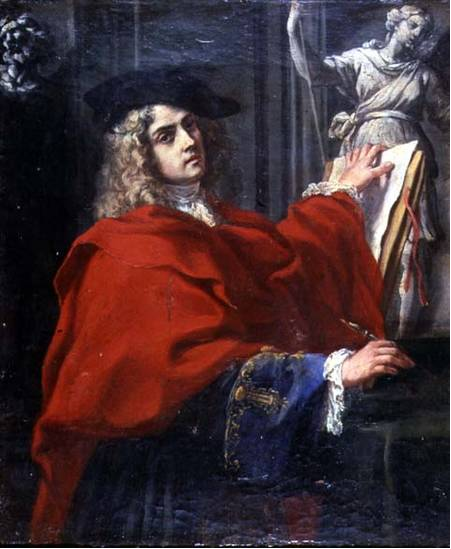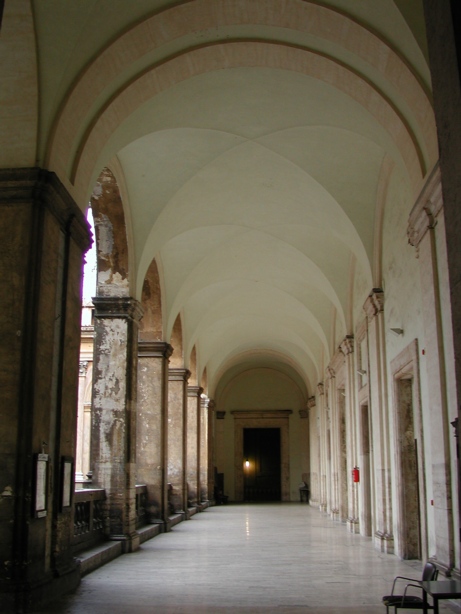|
Giovanni Francesco Albani
Pope Clement XI ( la, Clemens XI; it, Clemente XI; 23 July 1649 – 19 March 1721), born Giovanni Francesco Albani, was head of the Catholic Church and ruler of the Papal States from 23 November 1700 to his death in March 1721. Clement XI was a patron of the arts and of science. He was also a great benefactor of the Vatican Library; his interest in archaeology is credited with saving much of Rome's antiquity. He authorized expeditions which succeeded in rediscovering various ancient Christian writings and authorized excavations of the Catacombs of Rome, Roman catacombs. Biography Early life Giovanni Francesco Albani was born in 1649 in Urbino to the Albani family, a distinguished family of Albanians, Albanian origin in central Italy. His mother Elena Mosca (1630-1698) was a high-standing Italian of Bergamo, bergamasque origin, descended from the noble Mosca family of Pesaro. His father Carlo Albani (1623-1684) was a patrician. His mother descended in part from the Staccoli f ... [...More Info...] [...Related Items...] OR: [Wikipedia] [Google] [Baidu] |
List Of Popes
This chronological list of popes corresponds to that given in the ''Annuario Pontificio'' under the heading "I Sommi Pontefici Romani" (The Roman Supreme Pontiffs), excluding those that are explicitly indicated as antipopes. Published every year by the Roman Curia, the ''Annuario Pontificio'' no longer #Numbering of popes, identifies popes by regnal number, stating that it is impossible to decide which pope represented the legitimate succession at various times. The 2001 edition of the ''Annuario Pontificio'' introduced "almost 200 corrections to its existing biographies of the popes, from St Peter to John Paul II". The corrections concerned dates, especially in the first two centuries, birthplaces and the family name of one pope. The term ''Pope (word), pope'' ( la, text=papa, translation=father) is used in several churches to denote their high spiritual leaders (for example Coptic pope). This title in English usage usually refers to the head of the Catholic Church. The Cathol ... [...More Info...] [...Related Items...] OR: [Wikipedia] [Google] [Baidu] |
Albanians
The Albanians (; sq, Shqiptarët ) are an ethnic group and nation native to the Balkan Peninsula who share a common Albanian ancestry, culture, history and language. They primarily live in Albania, Kosovo, North Macedonia, Montenegro, Serbia as well as in Croatia, Greece, Italy and Turkey. They also constitute a large diaspora with several communities established across Europe, the Americas and Oceania. Albanians have Paleo-Balkanic origins. Exclusively attributing these origins to the Illyrians, Thracians or other Paleo-Balkan people is still a matter of debate among historians and ethnologists. The first certain reference to Albanians as an ethnic group comes from 11th century chronicler Michael Attaleiates who describes them as living in the theme of Dyrrhachium. The Shkumbin River roughly demarcates the Albanian language between Gheg and Tosk dialects. Christianity in Albania was under the jurisdiction of the Bishop of Rome until the 8th century AD. Then, dioceses ... [...More Info...] [...Related Items...] OR: [Wikipedia] [Google] [Baidu] |
Santa Cecilia In Trastevere
Santa Cecilia in Trastevere is a 5th-century church in Rome, Italy, in the Trastevere rione, devoted to the Roman martyr Saint Cecilia (early 3rd century AD). History The first church on this site was founded probably in the 3rd century, by Pope Urban I; it was devoted to the young Roman woman Cecilia, martyred it is said under Marcus Aurelius Severus Alexander (A.D. 222–235). Tradition holds that the church was built over the house of the saint. The baptistery associated with this church, together with the remains of a Roman house of the early Empire, was found during some excavations under the Chapel of the Relics. By the late fifth century, at the Synod of 499 of Pope Symmachus, the church is mentioned as the ''Titulus Ceciliae''. On 22 November 545, Pope Vigilius was celebrating the feast of the saint in the church, when the emissary of Empress Theodora, Anthemius Scribo, captured him. Pope Paschal I rebuilt the church in 822, and moved here the relics of St Cecilia f ... [...More Info...] [...Related Items...] OR: [Wikipedia] [Google] [Baidu] |
Museo Di Roma
The Museo di Roma is a museum in Rome, Italy, part of the network of Roman civic museums. The museum was founded in the Fascist era with the aim of documenting the local history and traditions of the "old Rome" that was rapidly disappearing, but following many donations and acquisitions of works of art is now principally an art museum. The collections initially included 120 water-colours by the nineteenth-century painter Ettore Roesler Franz of ''Roma sparita'', "vanished Rome", later moved to the Museo di Roma in Trastevere. History The museum was founded by the art historian , who was director of the Antichità e Belle Arti ("antiquities and fine arts department") of the government of Rome. It was the first civic museum of the city. It was housed in the , a large former pasta factory in Piazza Bocca della Verità, overlooking the Circo Massimo in the via dei Cerchi, in the Ripa rione of the city. The factory building also housed the Museo dell'Impero Romano, and was renam ... [...More Info...] [...Related Items...] OR: [Wikipedia] [Google] [Baidu] |
Pier Leone Ghezzi
Pier Leone Ghezzi (28 June 1674 – 6 March 1755) was an Italian Rococo painter and caricaturist active in Rome. Biography Ghezzi was born and died in Rome. He trained under his father, Giuseppe Ghezzi, who also trained Antonio Amorosi. His father was secretary of the Roman Accademia di San Luca, and Pier Leone joined the Academy in 1705. His essay painting, the ''Allegory of Gratitude'', was donated to the institution for his admission, as was customary. He painted for various churches such as the Cappuccini of Frascati and San Onofrio of Urbino. He was the godson of Carlo Maratta. Pier Leone is known for his frescoes in the Villa Falconieri of Frascati. As a painter, his style changes quite much through the years, sometimes under the influence of French portraiture. His pen and gouache caricatures are much freer in emotion than his state portraiture, and were much admired. They often depict named individuals or professions in satirical fashion.Memorie intorno i lette ... [...More Info...] [...Related Items...] OR: [Wikipedia] [Google] [Baidu] |
Orvieto
Orvieto () is a city and ''comune'' in the Province of Terni, southwestern Umbria, Italy, situated on the flat summit of a large butte of volcanic tuff. The city rises dramatically above the almost-vertical faces of tuff cliffs that are completed by defensive walls built of the same stone, called ''tufa''. History Etruscan era The ancient city (''urbs vetus'' in Latin, whence "Orvieto"), populated since Etruscan times, has usually been associated with Etruscan Velzna, but some modern scholars differ. Orvieto was certainly a major centre of Etruscan civilization; the archaeological museum (Museo Claudio Faina e Museo Civico) houses some of the Etruscan artifacts that have been recovered in the immediate area. A tomb in the Orvieto Cannicella necropolis bears the inscription ''mi aviles katacinas'', "I am of Avile Katacina"; the tomb's occupant thus bore an Etruscan-Latin first name, Aulus, and a family name that is believed to be of Celtic origin (derived from "Catacos"). Th ... [...More Info...] [...Related Items...] OR: [Wikipedia] [Google] [Baidu] |
Sabina (region)
Sabina (Latin: ''Sabinum''), also called the Sabine Hills, is a region in central Italy. It is named after Sabina, the territory of the ancient Sabines, which was once bordered by Latium to the south, Picenum to the east, ancient Umbria to the north and Etruria to the west. It was separated from Umbria by the River Nar, today's Nera, and from Etruria by the River Tiber. Today, Sabina is mainly northeast of Rome in the regions Lazio, Umbria and Abruzzo. ''Upper Sabina'' is in the province of Rieti (Poggio Mirteto, Magliano Sabina, Casperia, Montopoli di Sabina, Torri in Sabina, Cantalupo in Sabina, Montebuono, Forano, Poggio Catino, Montasola, Stimigliano, Castelnuovo di Farfa, Fara in Sabina, Roccantica, Mompeo, Salisano, Cottanello, Configni, Vacone, Tarano, Collevecchio, Toffia, Poggio Nativo, Scandriglia ecc.). ''Sabina Romana'' is in the province of Rome (Mentana, Monteflavio, Montelibretti, Monterotondo, Montorio Romano, Moricone, Nerola, Palombara Sabina). Part of ... [...More Info...] [...Related Items...] OR: [Wikipedia] [Google] [Baidu] |
Rieti
Rieti (; lat, Reate, Sabino: ) is a town and ''comune'' in Lazio, central Italy, with a population of 47,700. It is the administrative seat of the province of Rieti and see of the diocese of Rieti, as well as the modern capital of the Sabina region. The town centre stands on a small hilltop, commanding from the southern edge the wide Rieti valley, at the bottom of the Sabine hills and of monti Reatini, including mount Terminillo. The plain was once a large lake, drained by the ancient Romans, and is now the fertile basin of the Velino River. Only the small Ripasottile and Lungo lakes remain of the larger original. History Prehistory According to the legend, Reate was founded by Rea, a divinity (that would be the origin of the town name). It was founded at the beginning of the Iron Age (9th–8th century BC). Probably in earlier times the lands around Rieti were inhabited by Umbri, then by Aborigines and later on by Sabines, who reached the lands sited in the nearby of Te ... [...More Info...] [...Related Items...] OR: [Wikipedia] [Google] [Baidu] |
Apostolic Signatura
The Supreme Tribunal of the Apostolic Signatura () is the highest judicial authority in the Catholic Church (apart from the pope himself, who as supreme ecclesiastical judge is the final point of appeal for any ecclesiastical judgment). In addition, it oversees the administration of justice in the church.Apostolic constitution ''Pastor Bonus'', 121-125 (translation revised by the Secretariat of State (Holy See)). Since 8 November 2014, the prefect of the Supreme Tribunal of the Apostolic Signatura has been Cardinal |
Queen Christina Of Sweden
Christina ( sv, Kristina, 18 December (New Style) 1626 – 19 April 1689), a member of the House of Vasa, was Queen of Sweden in her own right from 1632 until her abdication in 1654. She succeeded her father Gustavus Adolphus upon his death at the Battle of Lützen in 1632, but began ruling the Swedish Empire when she reached the age of eighteen in 1644. The Swedish queen is remembered as one of the most learned women of the 17th century. She was fond of books, manuscripts, paintings, and sculptures. With her interest in religion, philosophy, mathematics, and alchemy, she attracted many scientists to Stockholm, wanting the city to become the "Athens of the North". The Peace of Westphalia allowed her to establish an academy or university when and wherever she wanted. In 1644, she began issuing copper in lumps as large as fifteen kilograms to serve as currency. Christina's financial extravagance brought the state to the verge of bankruptcy, and the financial difficulties cau ... [...More Info...] [...Related Items...] OR: [Wikipedia] [Google] [Baidu] |
Collegio Romano
The Roman College ( la, Collegium Romanum, it, Collegio Romano) was a school established by St. Ignatius of Loyola in 1551, just 11 years after he founded the Society of Jesus (Jesuits). It quickly grew to include classes from elementary school through university level and moved to several successive locations to accommodate its burgeoning student population. With the patronage of Pope Gregory XIII, the final seat of the Roman College was built in 1584 near the center of Rome's most historic Pigna district, on what today is called Piazza del Collegio Romano, adding the church of St. Ignatius in 1626, and a renowned observatory in 1787. The college remained at this location for 286 years until the revolutionary Capture of Rome in 1870.In 1870, the new Italian government confiscated the property of the university and their building (that eventually became the Ennio Quirino Visconti Liceo Ginnasio), which forced the university to transfer to the Palazzo Gabrielli-Borromeo on the ... [...More Info...] [...Related Items...] OR: [Wikipedia] [Google] [Baidu] |






